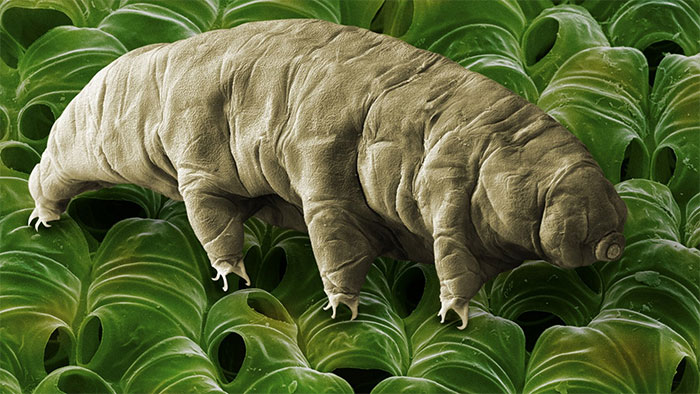New species of water bear reveals the secret of immortality
Understanding the genes that make these tiny creatures resistant to radiation could open up a range of applications, from cancer treatment to space exploration.
A newly discovered species of tardigrade is helping scientists better understand what makes the tiny eight-legged creatures so incredibly resistant to radiation.
Tardigrades, also known as water bears, have long fascinated scientists with their ability to survive extreme conditions, including radiation levels nearly 1,000 times higher than the lethal dose for humans. Of the approximately 1,500 known species of tardigrade, only a handful have been thoroughly studied.
Now, scientists have decoded the genome of a new species and revealed the molecular mechanisms that underlie its extraordinary endurance. The study, published in the journal Science on October 24, identified thousands of tardigrade genes that become more active when exposed to radiation. These processes suggest an elaborate defense system that both protects DNA from radiation damage and repairs breaks when they occur.
The authors hope these insights could be applied to protect astronauts from radiation on space missions, deal with nuclear contamination or improve cancer treatment.
"This discovery may help enhance the stress resistance of human cells, which could benefit patients undergoing radiotherapy ," said study co-author Dr. Lingqiang Zhang, a molecular and cellular biologist at the Beijing Lifeomics Institute.

Water bears - Tiny tardigrada arthropods that live underwater. (Photo: Earth Life).
The "immortal" genes
About six years ago, Zhang and his colleagues went to Funiu Mountain in Henan Province, China, to collect moss samples. Under a microscope in the laboratory, they discovered a previously unrecorded species of tardigrade, which they named Hypsibius henanensis . Genetic sequencing revealed that the species has 14,701 genes, of which 30% are unique to tardigrades.
When the researchers exposed H. henanensis to radiation doses of 200 and 2,000 grays—far above the human survival threshold—they found that 2,801 genes involved in DNA repair, cell division, and immune response became active.
'It's like during wartime, factories are converted to just make ammunition. The level of gene expression reorganization is almost the same,' says Bob Goldstein, a cell biologist at the University of North Carolina at Chapel Hill who has studied tardigrades for 25 years. 'We're fascinated by how an organism can change its gene expression to such an extent that it produces such a large amount of transcription for specific genes.'
One of these genes, called TRID1 , encodes a protein that helps repair double-strand breaks in DNA by recruiting specialized proteins to the site of damage. 'This is a new gene that, as far as I know, no one has studied ,' Goldstein said.
The researchers also estimated that 0.5–3.1 percent of tardigrade genes were acquired from other organisms through a process called horizontal gene transfer. The DODA1 gene, which appears to have been acquired from bacteria, helps tardigrades produce four antioxidant pigments called betalains. These pigments can remove some of the harmful reactive chemicals produced by radiation in cells, which account for 60–70 percent of the damaging effects of radiation.
The authors treated human cells with one of the tardigrade betalains and found that they survived much better than untreated cells when exposed to radiation.
Potential for creating drugs without expiration dates
Studying the molecular mechanisms that help tardigrades withstand other harsh conditions, such as extreme temperatures, lack of air, dehydration and starvation, could have many applications. For example, it could improve the shelf life of perishable substances like vaccines. 'Every drug has an expiration date – tardigrade does not,' says Dr Goldstein.
Comparing these mechanisms between different tardigrade species was an important part of the study, says Nadja Møbjerg, an animal physiologist at the University of Copenhagen. 'We still lack knowledge about the different tardigrade species that have not been explored ,' she says.
According to Mr. Goldstein, tardigrades contain a treasure trove of undiscovered protective substances. "Our goal is to understand the mechanisms of action and exploit the potential of these substances," he said.
- This little 'monster' is holding the secret of immortality of humanity
- The Secret of the Immortal Tardigrade: A Creature That Fears No Challenge!
- People are about to grasp the secret of immortality?
- Shocked with 'monster' resurrected after being eaten, calmly mating, giving birth
- Scientists have just shown how the 'immortal' creature on Earth goes
- The shape of the newly discovered water bear in Japan
- Will the 'immortal' really only die when the Sun explodes?
- The secret to dive deep dolphins without fainting
- Breakthrough in research 'Aphrodisiacs' helps children forever
- Find the source of human immortality beliefs
- Advertisement film protecting the bear
- The cause of human immortality
 Animal 'suffering' after hibernation
Animal 'suffering' after hibernation Why do goats climb well?
Why do goats climb well? Scientists were surprised to see chimpanzees eating turtles
Scientists were surprised to see chimpanzees eating turtles Giant catfish died deadly due to drought in Thailand
Giant catfish died deadly due to drought in Thailand